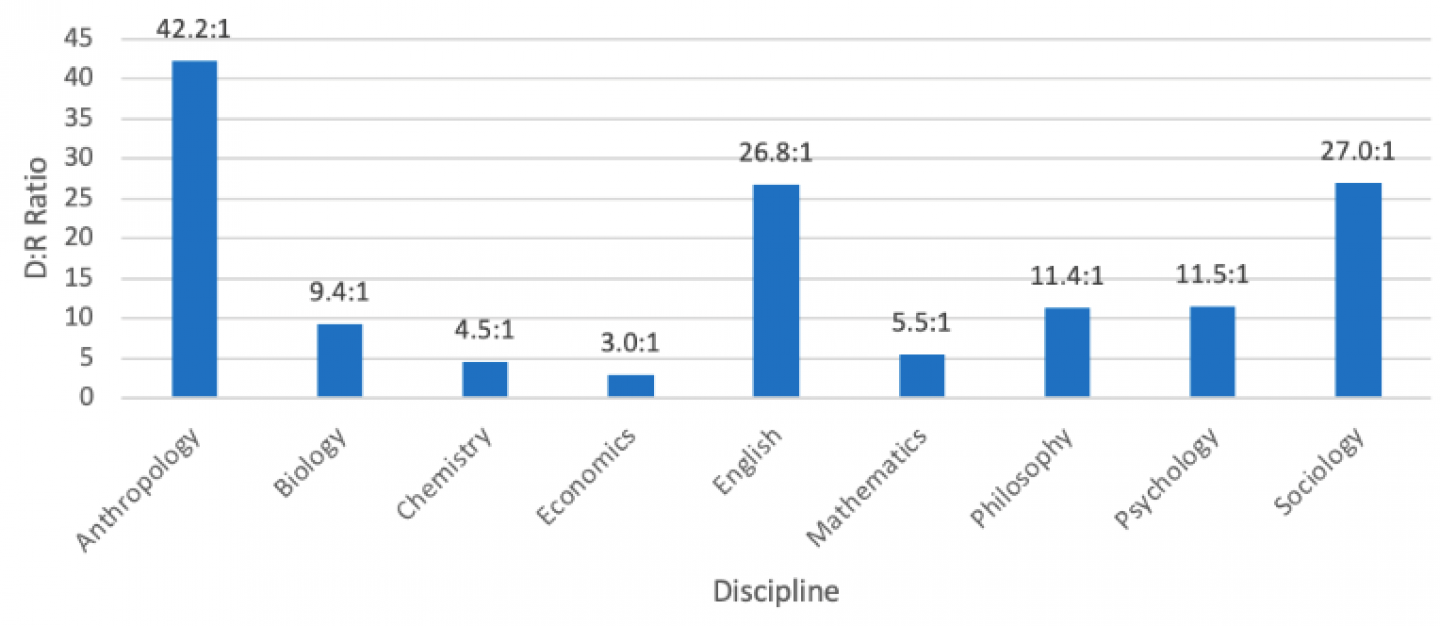Partisan Registration and Contributions of Faculty in Flagship Colleges
Bottom Line: In a survey of 12,372 American university professors, 48.4 percent are registered Democrats and 5.7 percent are registered Republicans, a ratio of 8.5:1. This ratio is nearly eight times larger than that of the general population, where 29 percent are Democrats and 26 percent are Republicans, a ratio of 1.1:1.
A significant amount of academic research has noted a large imbalance between Democrats and Republican professors on college campuses. This survey builds on this literature with additional findings:
- Although the ratio of faculty who identify as or are registered as Democratic versus Republican varies across departments, it almost always favors the Democratic Party.
- The D:R registration ratio is typically higher among disciplines in the humanities and social sciences compared to those in the natural sciences and engineering.
- The D:R registration ratio has increased over time, from roughly 4.5:1 in 1999 to 10:1 among elite liberal arts colleges and social science departments now.
- The partisan slant is most extreme in the most highly rated institutions.
In all nine academic disciplines that this survey measured, the D:R registration ratio favors the Democratic Party. Broadly, the natural sciences are the least politically homogenous, with the D:R registration ratio ranging from 4.6:1 (chemistry) to 9.4:1 (Biology). In the social sciences, the D:R registration ratio varies to a much greater extent. Economics has the smallest D:R registration ratio at 3:1 among all nine disciplines, while anthropology has the largest at 42.2:1.
Region is also associated with differences in the D:R registration ratio, which was highest at colleges located in the Northeast (15.4:1). This is consistent with previous work suggesting that political homogeneity among professors is higher in the Northeast (New England, in particular) compared to the rest of the country. The D:R registration ratio in the Northeast is also roughly three times the size of the D:R registration ratio in the Midwest (4.7:1). The South’s D:R ratio may be elevated by remnants of its traditional association with the Democratic Party.
The D:R registration ratio among female faculty (16.4:1) is more than twice the D:R registration ratio among male faculty (6.4:1). Roughly two-thirds of the faculty sampled are male.
Differences in the D:R registration ratio by professor rank are also evident, and it was highest among assistant professors (10.5:1) compared to associate (8.7:1) and full professors (8.2:1).
The overall D:R donation ratio was 95:1. Among the 12,372 professors sampled, in raw numbers, there were 10,260 nondonors, 2,081 Democratic donors, 22 Republican donors, and 9 donors to both parties across both election cycles.
Read the full study here.
Democrat to Republican College Faculty Ratio By Discipline

Findings:
- Although the ratio of faculty who identify as or are registered as Democratic versus Republican varies across departments, it almost always favors the Democratic Party.
- Broadly, the natural sciences are the least politically homogenous, with the D:R registration ratio ranging from 4.6:1 (Chemistry) to 9.4:1 (Biology).
- In the social sciences, the D:R registration ratio varies to a much greater extent. Economics has the smallest D:R registration ratio at 3:1 among all nine disciplines, while anthropology has the largest at 42.2:1.
Read the full study here.




